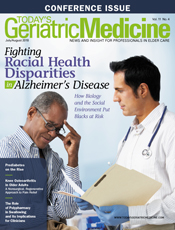
July/August 2018
Focus on Fitness: Tips to Prevent Osteoporosis In osteoporosis, which literally means "porous bone," bones lose density or mass, weaken, and become more susceptible to fracture. Osteoporosis commonly occurs with age—menopausal women are at highest risk. Other risk factors include a sedentary lifestyle, low body weight, smoking, and calcium and/or vitamin D deficiency. Certain medications (eg, steroids, proton pump inhibitors) and diseases (eg, lupus, hyperthyroidism, certain cancers) also increase the risk of developing osteoporosis. According to the National Osteoporosis Foundation (NOF), approximately 10 million Americans have osteoporosis, and an additional 44 million have low bone density, making them at risk of osteoporosis—that's about one-half of American adults older than 50. One in two women and up to one in four men aged 50 and older will break a bone due to osteoporosis. Bone fracture is a serious complication of osteoporosis and usually occurs in the hip, spine, or wrist. Hip fractures are especially dangerous and debilitating for older adults; 20% of those who fracture a hip die within one year from complications of the fracture or surgical repair. Those who do survive typically lose mobility and may require assistance at home or admission to a long term care facility. Exercise is key to preventing osteoporosis. Though most adults don't begin to think about prevention until they're approaching age 50, appropriate exercise as early as adolescence helps build bone density and prevent osteoporosis. Every year for National Osteoporosis Month, the NOF sponsors the Jumping Jack Challenge for families to build awareness of the disease starting at an early age and to encourage exercise to prevent osteoporosis (www.nof.org/about-us/building-awareness/ Exercise for Prevention In addition to weight-bearing exercise, muscle-strengthening exercises also are recommended, including lifting weights, using weight/strength machines, exercises with resistance bands, body weight exercises (eg, push-ups, certain yoga poses), and functional movements (eg, squats, lunges, toe raises). Because muscles support bones, building and maintaining strength through resistance exercise helps in preventing osteoporosis. Both weight-bearing and muscle-strengthening exercises should be performed multiple times weekly. Stretching exercises also should be performed to maintain flexibility and reduce the likelihood of injury. Swimming and cycling aren't considered weight-bearing exercise because the body is supported by the water or bicycle. Both are popular and excellent cardiorespiratory conditioning activities; however, they shouldn't be performed to the exclusion of other weight-bearing exercise. From the perspective of osteoporosis prevention, swimming and cycling do serve as muscle strengthening activities, but other weight-bearing exercise should be regularly performed to build bone strength. Exercising With Osteoporosis Safe and appropriate exercise should be continued regularly, because it can help build bone, even in osteoporotic individuals, and help maintain or improve balance and strength to prevent falls, which carry an increased risk of fracture for those with osteoporosis. An osteoporosis diagnosis can be devastating for an active exerciser because it requires modification of exercise activities. For clients with osteoporosis, obtaining bone density test results and physician clearance for exercise, with guidance on unsafe exercises for their symptoms, is essential. A review of all exercise activities should be conducted to flag potential risks for osteoporotic fracture. For example, a client who regularly practices gentle yoga may think that forward folds will help with back and hip flexibility, when they will actually stress the spine and increase the risk of spinal fractures. Mat Pilates exercises that involve spinal rolling or vigorous leg lifting may feel good for muscles, but also put stress on the spine and hip and increase fracture risk. An active golfer may not realize that twisting movements during the golf swing can lead to spinal or hip fractures. The extent of the disease should guide exercise choices. For example, an active woman in her 50s who shows signs of lower bone density may be able to continue most of her exercise activities with minor modifications, like replacing high-impact jogging with low-impact workouts on the elliptical machine. An inactive man in his early 70s with more advanced osteoporosis and a high risk of bone fracture may be limited to water exercise to build muscle strength and only supervised strength training on land. In general, an exercise program for those with osteoporosis should include the following: • weight-bearing exercise appropriate for the individual's bone density and symptoms, or nonweight-bearing exercise (eg, swimming, water walking/aerobics, tai chi) to improve balance, strength, and physical conditioning if weight-bearing exercise isn't recommended or isn't possible; • strength training exercises geared toward fitness level and ability, usually no harder than moderate intensity; • functional exercises to improve ability to perform activities of daily living (eg, getting up from a chair, walking up stairs); • balance exercises to improve stability and decrease the risk of falls; and • postural exercises to increase strength and range of motion in the shoulders, decrease the "hunchback" posture from rounded shoulders, and reduce the risk of spinal stress and fracture. Depending on the extent of disease and fracture risk, some clients with osteoporosis may require a consultation with a physical therapist to provide exercise guidance and modifications, or supervised exercise with a qualified professional trained in osteoporosis management. The NOF has some resources for exercising safely with osteoporosis: • Safe Movement & Exercise Videos: www.nof.org/patients/fracturesfall-prevention/safe-movement-exercise-videos; • Pilates Guidance: https://cdn.nof.org/wp-content/uploads/2016/06/Safe-Pilates_NOF-Flyer_BETZ. • Yoga Guidance: https://cdn.nof.org/wp-content/uploads/2016/05/Safe-Yoga-NOF-Flyer-2016.pdf. The International Osteoporosis Foundation provides more detailed guidance on exercise for prevention and exercising with osteoporosis at www.iofbonehealth.org/exercise-recommendations. Resources 2. Pfeifer M, Minne HW. Exercise recommendations. International Osteoporosis Foundation website. https://www.iofbonehealth.org/exercise-recommendations 3. New national survey reveals 82 percent of postmenopausal women miss critical connection between osteoporosis and bone fractures. National Osteoporosis Foundation website. https://www.nof.org/news/new-national-survey-reveals-82-percent-postmenopausal-women-miss-critical-connection-osteoporosis-bone-fractures/. Published August 10, 2017. |
